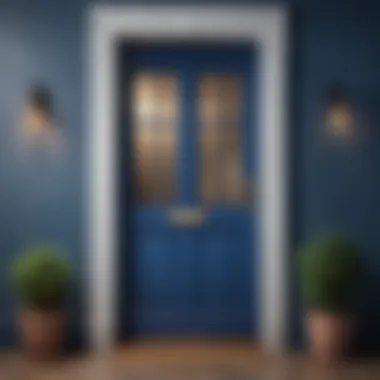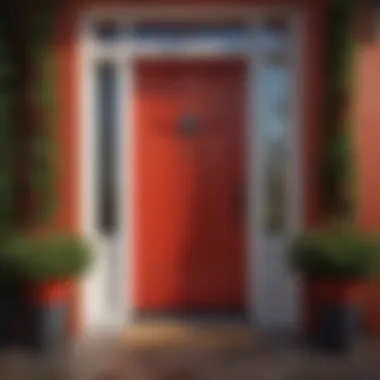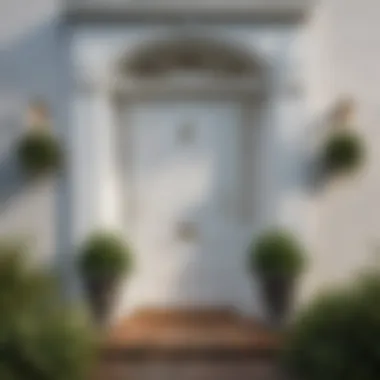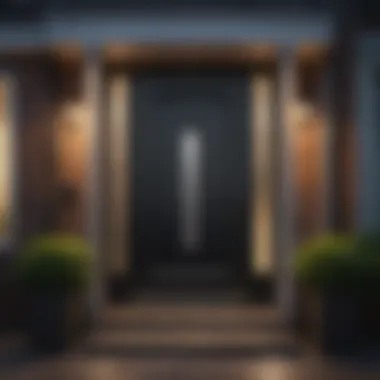The Best Colour to Paint Your Front Door: A Comprehensive Guide


Intro
Choosing the right colour for your front door is more than a simple aesthetic decision. It influences how your home is perceived, not just by others, but by yourself as well. A front door serves as an invitation into your space; it represents your personal style and warmth. The colour can reflect your personality while enhancing the overall curb appeal of your home. As such, understanding the significance behind various colours can greatly inform your selection process.
This guide explores various aspects of front door colours, focusing on aesthetics, psychological effects, and practical considerations. By delving into trending styles, popular shades, and essential advice, homeowners can make informed decisions that elevate their home's entrance.
Key topics include:
- Importance of Colour Choices: Discusses how colour impacts perceptions and feelings.
- Trending Styles and Themes: Looks at current trends in door colours and styles.
- Color Palettes and Combinations: Offers suggestions for complementary colour schemes.
With this insight, you will be equipped to select a front door colour that not only suits your architectural style but also resonates with your personal style and enhances your home's overall appeal.
Understanding the Importance of Front Door Colour
The colour of your front door serves as a significant statement about your home. It acts as the first line of communication between your residence and the outside world. A well-chosen hue can elevate the aesthetic value of your property while demonstrating your unique identity and taste. This section will explore the essential factors that highlight the importance of selecting the right colour for your front door.
Key Considerations:
- Visibility: A distinct colour can enhance your home’s visibility among similar-looking houses. A vibrant shade grabs attention and ensures your house stands out in the neighborhood.
- Significance in Home Design: Colour is a key element in design, influencing both exterior appeal and interior perception. A thoughtful choice can create a seamless transition between inside and outside.
- Cultural and Social Reflections: Colours can represent various cultural meanings. Choosing a particular shade might convey certain social values or sentiments. For instance, red doors are often seen as symbols of welcome and warmth.
Understanding these dynamics can empower homeowners to make choices that not only beautify their entrance but resonate with personal and community identities.
The Role of First Impressions
First impressions matter. Your front door is the first point of contact for visitors, and it shapes their initial perception of your home. The colour of the door can instantly communicate your home’s character, influencing how guests feel before they even step inside.
A bright, cheerful colour may evoke feelings of friendliness and hospitality, while a darker hue might convey elegance and sophistication. The tone you choose can also hint at the interior decor style. For example, a farmhouse-style home might benefit from a soft pastel, whereas a modern structure could be complemented by a bold, vibrant colour.
In addition, a unique colour can become a conversation starter. Visitors may feel inclined to compliment the door colour, thus creating an opening for engagement. Impressing guests at your door step can elevate the entire visiting experience.
Psychological Effects of Colour
The psychological impact of colour is well studied. Each hue can elicit specific emotions and reactions. Understanding these effects is crucial when choosing the right front door colour.
- Bold colours, such as red or orange, often evoke excitement or energy. These colours can create an inviting atmosphere, motivating guests to enter your home with enthusiasm.
- Cooler tones like blue or green can induce calmness and tranquility. Such choices may suggest a peaceful sanctuary within, appealing to those who prioritize relaxation.
- Neutral colours, such as grey or beige, can convey simplicity and sophistication. These selections often give a clean, modern look, fitting for various architectural styles.
By being aware of what different colours represent, homeowners can select a colour that aligns with the desired emotional tone they want to project. Understanding the psychological effects of colour not only impacts curb appeal but also sets the stage for the overall ambiance of your home.
Popular Front Door Colours and Their Meanings
Choosing the right colour for your front door goes beyond simple aesthetics. It is an expression of your personal style and can significantly affect the overall appearance of your home. The front door serves as a gateway, setting the tone for visitors before they even step inside. Different colours convey unique meanings and evoke various feelings, which makes this choice crucial for your home's first impression.
A well-chosen colour can enhance curb appeal and make your property more inviting. Furthermore, understanding the significance behind popular door colours can help homeowners make informed decisions that align with their preferences and values. Below, we explore some classic options and their implications.
Classic Red
Classic red is a time-honoured choice for front doors, symbolizing warmth and welcome. This shade is bold and attention-grabbing, making a strong statement about the inhabitants within. Red is often associated with energy, passion, and strength. By choosing a red door, homeowners can express confidence and create an inviting atmosphere.
Historically, red doors have also been linked to safety and good luck. In some cultures, a red door signifies a safe haven, enhancing its appeal further. Thus, opting for a red door not only boosts the visual interest of your home but also communicates positive feelings to those who approach.
Elegant Black
Black doors exude sophistication and elegance. This colour resonates with a modern aesthetic, appealing to those who appreciate minimalism. A black door can complement many architectural styles, from traditional to contemporary, making it a versatile option.
Beyond its visual appeal, black carries connotations of strength, authority, and formality. It leaves a lasting impression while also framing the overall design of your home. Additionally, a black door can easily harmonize with various fixtures, such as brass or silver handles, enhancing the overall look without becoming overwhelming.


Charming Blue
Blue doors often evoke feelings of tranquility and calmness. This colour is commonly associated with stability and reliability, making it a popular choice for many homeowners. Light shades of blue can create a coastal vibe, while darker blues convey a more classic look.
Choosing blue for your front door invites a sense of peace, encouraging an inviting atmosphere. This colour connects the interior to the outdoor environment, making it suitable for homes surrounded by nature. The serenity provided by blue can bring a cohesive and inviting feel to your property.
Warm Yellow
Yellow is a bright and cheerful option for front doors, representing happiness and optimism. This colour can instantly uplift the mood of both the homeowner and visitors, making a welcoming impression.
A yellow door can serve as a striking focal point, especially for homes with neutral exteriors. It is a reflection of a sunny disposition and can brighten even the gloomiest days. This choice may not be for everyone, but for those who wish to express vibrancy and warmth, a yellow door can be an excellent fit.
Sleek Grey
Grey offers a modern and elegant alternative. It represents neutrality and balance, making it an attractive choice for a variety of home styles. As a subdued colour, grey has the ability to blend well with numerous exteriors while still providing a refined look.
This colour choice does not overpower but rather enhances the architectural details of a home. Grey doors can convey sophistication without being too flashy, appealing to discerning homeowners with a taste for understated elegance. Additionally, grey is versatile and adapts well to changing design trends, ensuring your home remains stylish over time.
Overall, selecting a front door colour is an essential decision that influences your home's character. Each shade carries its own meaning and speaks to potential visitors. By considering how each colour aligns with your personal style and reflecting on its underlying implications, you can choose a front door that elevates your home's curb appeal.
Considerations Before Choosing a Colour
Choosing the right colour for your front door is a decision that extends beyond mere aesthetics. It involves several key considerations that influence not just the appearance of your home, but also how it interacts with its surroundings. A well-selected colour can enhance your home’s architectural features, boost curb appeal, and even reflect your personal style. This section details essential factors you need to ponder before settling on a hue for your entrance.
Architectural Style
The architectural style of your home serves as a fundamental basis for colour choice. Each style has its own character and aesthetic rules. For instance, a Victorian-style home might inspire more vibrant reds or deep greens, while a contemporary design may call for minimalistic shades like charcoal or crisp white.
Consider these aspects:
- Compatibility: Ensure the door colour complements the overall design elements, such as window trim, siding, and roofing materials.
- Historical Context: If you own a historic property, research traditional colours prevalent in that period. This respect for history can add value and charm.
- Local Trends: Observe what colours are common in your neighbourhood. While distinctiveness is important, too radical a departure might seem out of place.
Local Environment
Beyond architectural style, the local environment plays a significant role in selecting a front door colour. Geography, climate, and neighbourhood characteristics will affect not only the paint’s longevity but also its appeal.
Consider the following:
- Climate: Bright colours can fade faster in sunny regions, while darker shades may absorb heat. Assess how different colours withstand local weather elements.
- Surrounding Houses: Take stock of neighbouring homes. Your chosen colour should enhance your property’s appeal without clashing with those nearby.
- Natural Landscape: If your home resides in a lush, green area, colours that provide contrast—like navy or a lively orange—can be striking.
Surrounding Landscaping
Your front door does not exist in isolation. The landscaping around your home creates a visual context that impacts how a door colour is perceived. Harmonizing the door colour with landscaping can create a cohesive look for your home.
Consider these factors:
- Flora and Fauna: The colors of your plants, trees, and flowers can dictate a palette. For example, if your garden features a lot of pastel blooms, a softer door colour will fit better.
- Seasonal Changes: Landscape colours shift with the seasons. A door colour should be versatile enough to look appealing year-round.
- Architectural Features: Pay attention to fences, pathways, and garden decorations. They should enhance, not detract from, your choice of door colour.
"Choosing a front door colour is not just about the door itself; it’s about creating a complete picture that resonates with both the home and its environment."
Assessing Your Home’s Curb Appeal
Assessing your home’s curb appeal involves an evaluation of the external appearance and attractiveness of your property. A front door is a key focal point, so its color can significantly impact overall perception. Understanding curb appeal is essential as it creates the first impression. When visitors or potential buyers approach your home, their initial observation influences their feelings towards the property. A well-chosen front door color can enhance your home’s charm, leading to positive associations.
Additionally, curb appeal can affect property value. Homes with strong visual appeal often attract higher offers in the market. Potential buyers may be more inclined to visit if the exterior looks inviting, which makes it crucial to select a color that fits both personal style and broader community aesthetics.


Considering your home’s architectural style, the character of the neighborhood, and the surrounding environment will guide you in making the right choice for color.
Creating Contrast
Creating contrast is an effective strategy in design. This technique helps certain features stand out and draw attention. For your front door, a contrasting color can elevate the appearance of your home. For instance, a bright color on a neutral house creates visual interest without overwhelming the senses. Additionally, contrast can guide the eye naturally to the entryway, making it more inviting.
Here are some tips for creating contrast with your front door color:
- Understand your base colors: Identify the primary and secondary colors of the home.
- Choose complementary colors: Use the color wheel to find contrasting shades that work well together.
- Consider seasonal adjustments: A bold color can be striking in the spring, while earthy tones might fit better in fall.
By thoughtfully applying contrast, you can make a striking statement with your front door.
Harmonizing with the Exterior
Harmonizing with the exterior focuses on integrating the front door color with the overall design of the property. While contrast is important, achieving harmony ensures that your door does not look out of place. It involves considering the colors of the siding, roof and trim elements. For instance, a rustic wooden house might benefit from a natural green or deep blue that echoes the surrounding landscape.
When selecting a harmonious color, consider the following points:
- Architectural elements: Examine the styles and hues already present on the property.
- Environment: Evaluate how nearby plants and structures can influence your color choice.
- Consistency in style: Ensure the new door color aligns with the home’s architectural design.
By harmonizing your front door color with your home’s exterior, you create a cohesive look that enhances attractiveness without compromising individual expression.
"Curb appeal serves as a silent ambassador for your home; it speaks volumes before anyone even steps inside."
Ultimately, assessing your home’s curb appeal encompasses both contrast and harmony. These elements should work together to present a graceful and appealing exterior that welcomes guests and reflects your personality.
Sustainable and Eco-Friendly Options
Choosing sustainable and eco-friendly options for your front door paint is a reflection of your values and a commendable way to contribute to environmental preservation. Such choices not only hold aesthetic promise but also come with practical benefits that resonate with a growing global awareness about sustainability. Using paint and materials that are non-toxic and environmentally friendly ensures that you are making a positive impact on your home and the larger community.
Environmental concerns are at the forefront of many homeowners' minds nowadays. The paints and materials used on your front door can influence not just the look of your home but also the health of the indoor environment. The significance of sustainable options lies in reducing harmful emissions and minimizing your carbon footprint. Selecting eco-friendly materials is also often about durability, as they tend to withstand the elements better and thus require less frequent recoating.
Non-Toxic Paints
Non-toxic paints are formulated without harmful chemicals such as volatile organic compounds (VOCs), which can be detrimental to both health and the environment. Lower VOC levels result in fewer fumes released into the air during and after application. This is especially crucial if you have children or pets at home. When considering non-toxic options, look for brands that offer paints free of toxic elements like lead and formaldehyde, ensuring a safer atmosphere in your home.
Moreover, non-toxic paints often incarnate vibrant colors that rival traditional paints. These options come in a variety of finishes and application styles, ensuring that aesthetic appeal does not come at the cost of health. Some well-known brands like Benjamin Moore and Behr have begun to offer selections that align with eco-friendly guidelines, giving you choices without compromising on beauty.
Recycled Materials
Recycled materials in paints and coatings offer a unique way to minimize waste while enhancing the sustainability aspect of your home décor. By selecting paints made from recycled substances, you are actively participating in the circular economy. These paints can incorporate elements reclaimed from post-consumer products which still provide durability and aesthetic quality.
Furthermore, using recycled materials often aligns with various sustainability certifications, giving you peace of mind. For example, look for certifications such as Green Seal or the EPA's Safer Choice label when evaluating the options. This indicates that the product meets stringent criteria for meaningful environmental benefits. Availability of recycled paint products is rising, which is indicative of a much-needed shift towards eco-conscious living.
"By making sustainable choices in home decor, we promote a culture of responsibility and care for our environment."
In summary, opting for sustainable and eco-friendly paints contributes to a healthier living space, reflects personal values, and promotes ecological responsibility. Both non-toxic paints and those made from recycled materials stand as vital components in creating a front door that is not only attractive but also kind to our planet.
Consulting with Professionals
Choosing the right colour for your front door extends beyond aesthetic preferences; it has strategic elements that require a thoughtful approach. Consulting with professionals can bring a nuanced understanding of design principles, trends, and environmental considerations that may not be apparent to most homeowners. These experts can help prevent potential missteps that could lead to dissatisfaction or an unharmonious look.
When engaging with a designer, knowledge of local architecture and community trends becomes essential. Designers can provide insights on whether a bold red or a gentle blue would complement your home’s style and neighborhood character. Moreover, these professionals can assist in identifying colours that align with existing elements such as siding, window frames, and landscaping.
Finding the Right Designer


The first step in consulting with professionals is identifying a designer who understands your vision. Look for a designer with experience in exterior colour consultations. Be sure to review their portfolio for past work that resonates with your style. Interviews or informal chats can reveal their approach to colour selection.
Considerations include:
- Their understanding of architectural styles
- Previous experience in similar projects
- Ability to collaborate effectively with your ideas
It is beneficial to find a designer who can communicate openly about wants, fears, and any constraints.
Collaborating on Colour Choices
Collaboration is key in achieving a final selection that both pleases you and fits your home’s architecture. Engaging a designer in colour selection promotes a back-and-forth exchange of ideas and offers expert advice on which shades will work best in your environment. Factors to discuss include:
- Trends vs. Timelessness: Discuss new trends against timeless options to ensure lasting appeal.
- Sample Testing: Experts can recommend tests using colour samples on your door to view how it interacts with natural light.
- Mood Considerations: Discuss how certain colours evoke feelings and how these might influence the atmosphere you wish to create.
When the alignment is right, the process can yield beautiful results that enhance your home’s curb appeal and reflect your personal style.
A well-chosen front door colour can serve as more than just a design element; it can elevate the overall aesthetics and value of your home.
Maintenance of Exterior Paint
Maintaining the finish of your front door is critical for both aesthetic and functional purposes. Exterior paint not only protects wood or metal from the elements but also enhances the overall look of your home. A door that is peeling, faded, or cracked can significantly detract from your curb appeal. Therefore, understanding the maintenance required for exterior paint is essential.
Regular upkeep ensures that your chosen color remains vibrant and does its job of safeguarding your door. Moreover, visible wear can affect the overall value of your property. Keeping your front door in good condition reflects a sense of pride and care in home ownership. Here are important elements to consider:
- Climate Impact: Weather conditions can hasten deterioration. Sun bleaching and moisture can alter paint integrity. If you live in a harsh climate, you may need to check your door more often.
- Quality of Paint: High-quality paints may require less frequent maintenance, making them a worthwhile investment.
- Initial Preparation: Proper surface preparation before painting can lead to longer-lasting results.
Having a strategy for maintaining your exterior paint leads to better decisions regarding the frequency of inspections and when to repaint.
Regular Inspections
Conducting regular inspections is a necessary part of maintaining your front door's paint. A proactive approach allows you to catch issues before they escalate. One should check for signs of peeling, bubbling, or discoloration. For best practices:
- Visual Assessment: Inspect for any damages. This should be done ideally every few months, especially after severe weather.
- Touch Test: Run your hand over the surface of the paint. If you feel rough spots, this might indicate damage beneath.
- Cleaning: Maintain cleanliness by gently washing the door with mild soap and water. This removes dirt and grime that can contribute to wear.
By staying vigilant, homeowners can extend the lifespan of their paintwork, saving time and resources in the long run.
Repainting Techniques
When it comes to repainting, techniques play a significant role in the durability of your front door's finish. Whether you're refreshing an existing color or changing it altogether, here are effective techniques to consider:
- Sanding: Before applying a new coat, sand the surface to promote adhesion. This is crucial, especially if the old paint is glossy.
- Primer Application: Use a primer suited for exterior use. It helps improve paint adherence and can enhance color vibrancy.
- Layering Coats: Apply multiple thin coats rather than one thick coat. This ensures even coverage and reduces the chances of drips.
- Proper Tools: Use brushes or rollers designed for exterior use. These tools can help you achieve a smooth finish.
"Quality techniques not only enhance appearance but fortify against harsh elements."
Ending: Making the Right Choice
Choosing the colour of your front door is more than a matter of personal preference; it has lasting implications. An effective colour choice contributes not only to the overall aesthetic appeal but also enhances the emotional atmosphere of your home. One must consider the relationship between colour and perception, as well as the influence it may have on guests and potential buyers. It is therefore crucial to approach this decision with care and thoughtful consideration.
Reflecting Personal Style
Your front door serves as the welcoming face of your home. Reflecting your personal style through the colour choice is essential. Each shade can communicate a different message about who you are. For instance, a bright yellow may convey warmth and friendliness, while a deep blue may project a sense of calm and stability.
When selecting a colour, think about your interior design, existing decor, and the overall mood you want to create. A cohesive colour palette can make a lasting impression, whereas mismatched or haphazard choices may detract from your home's visual appeal. It is beneficial to take inspiration from your surroundings as well, such as the textures of the landscape or adjacent buildings.
Enhancing Property Value
Apart from personal expression, the right colour can significantly enhance the value of your property. Real estate experts often highlight curb appeal as a major factor in home valuation. A front door that stands out for the right reasons can attract potential buyers, making them more likely to schedule viewings.
Consider neutral or classic shades that appeal to a wide audience. Rich tones, such as emerald green or navy blue, can also be particularly attractive when paired with contrasting trim colors. Additionally, colours that maintain their vibrancy over time can reduce the need for frequent repainting, thereby maintaining the aesthetic quality and value of your home.
"A well-chosen front door colour can be a game changer in property appeal."



